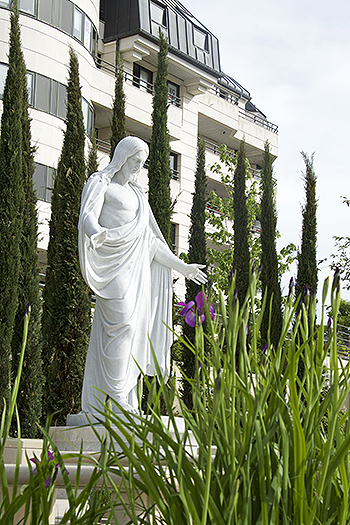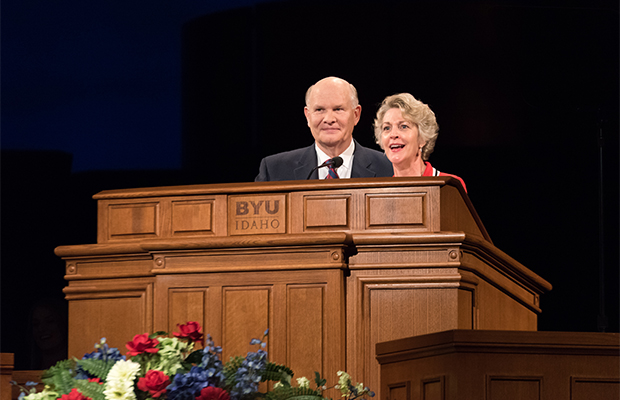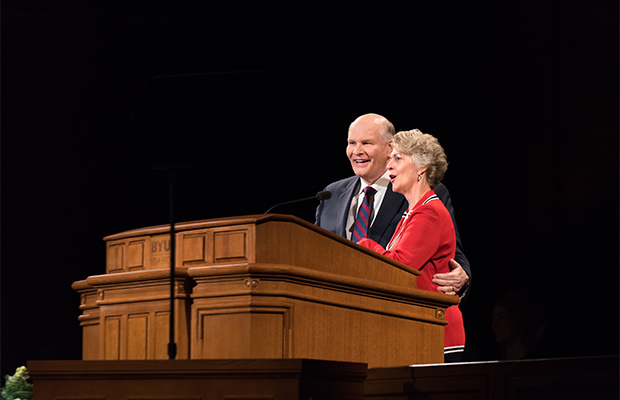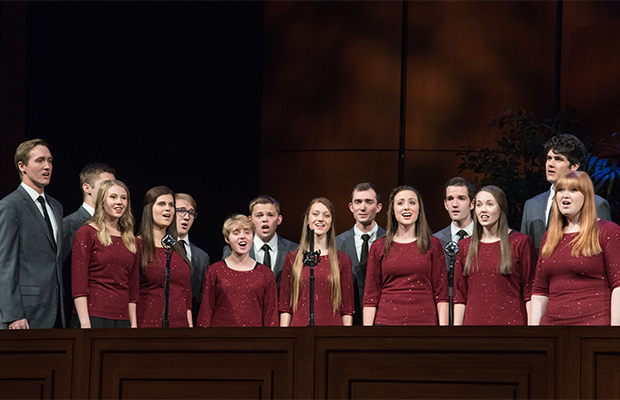Coming unto Christ Is Not a One-Time Event, Elder and Sister Renlund Tell BYU–Idaho Students
Contributed By Marianne Holman Prescott, Church News staff writer

Elder Dale G. Renlund of the Quorum of the Twelve Apostles and his wife, Sister Ruth L. Renlund, stand together and speak at a BYU–Idaho campus devotional on September 26, 2017.
Article Highlights
- When we receive the restored gospel, we come unto Christ.
- We must constantly repeat steps in the doctrine of Christ.
- The sacrament is key to coming unto Christ.
“Of all of the words that the Savior spoke, nothing is more pleading and important for us than ‘Come unto Christ.’” —Elder Dale G. Renlund of the Quorum of the Twelve Apostles
Related Links
REXBURG, IDAHO
Living the gospel is not a “one-time” event. Rather, individuals are able to become perfected by repeatedly relying upon the doctrine of Christ, Elder Dale G. Renlund of the Quorum of the Twelve Apostles taught during a campus devotional at Brigham Young University–Idaho on September 26. Joining him in giving the address was his wife, Sister Ruth L. Renlund.
Sharing about when they had the opportunity to help with the Paris France Temple open house earlier this year, Elder and Sister Renlund told of a large Christus statue—a copy of the 1838 original by the Danish sculptor Bertel Thorvaldsen—on the grounds of the temple.
“The statue is frequently referred to as the Christus Consolator,” Elder Renlund said. “A consolatory is one who consoles. To console means to comfort another at a time of grief or disappointment; to give solace, sympathize with, commiserate with, or show compassion for another. For us, the Christus statue conveys these divine attributes of the Savior.”

The large Christus statue—a copy of the 1838 original by the Danish sculptor Bertel Thorvaldsen—on the grounds of the Paris France Temple. Photo by Sarah Jane Weaver, Deseret News.
The original Christus Consolator is located in Vor Frue Kirke, the Church of Our Lady, in Copenhagen, Denmark. Both above and below the statue are inscriptions of well-known verses from the Bible.
On the top is “Denne er min son den elskelige Horer Ham,” which means “This is My Beloved Son: hear Him,” in English.
“On the pedestal on which the Christus Consolator stands are these words, in Danish, ‘Kommer til mig,’” Elder Renlund said. “In English, ‘Come unto me.’ Of all of the words that the Savior spoke, nothing is more pleading and important for us than ‘Come unto Christ.’”
Sister Renlund added, “With this original statue of Christus Consolator, we have both the Father’s invitation—to hear His Only Begotten Son—and the Son’s invitation to come unto Him. In perfect unity, They invite all to hear and to come.”
It is through the Atonement of Christ that all mankind can be saved, Elder Renlund said. Each person can only come unto Christ through receiving the restored gospel of Jesus Christ by having faith in Jesus Christ and His Atonement, repentance, baptism, receiving the gift of the Holy Ghost, and enduring to the end.
“This is the unified message of the Father and the Son,” Sister Renlund taught. “They want all Heavenly Father’s children to follow the doctrine of Christ. Just so there is no confusion, when we use the phrase, ‘the doctrine of Christ,’ it means the same as the gospel of Christ.”
Drawing from references in the scriptures, the Renlunds spoke of how Heavenly Father and Christ invite all to come unto Christ.
Elder Renlund noted that all carry burdens. “We may be burdened with sin, sorrow, addiction, sickness, guilt, or shame. In these difficulties, looking to Christ brings healing and hope and consolation. He will heal those who trust Him.”
The doctrine of Christ is not intended to be experienced as a one-time event, the Apostle taught.
“Our theology teaches us that we become perfected by repeatedly and iteratively ‘relying wholly upon’ the doctrine of Christ,” he said. ‘This means that we repeat the steps in the doctrine of Christ throughout our lives. Each step builds on the preceding step, and the sequence is intended to be experienced over and over again.”

Elder Dale G. Renlund of the Quorum of the Twelve Apostles and his wife, Sister Ruth L. Renlund, stand together and speak at a BYU–Idaho campus devotional on September 26, 2017. Photo by Garrett Blanchard.
Sister Renlund said as a person exercises faith, his or her faith grows stronger.
“As we continually seek to repent, we improve,” she said. “As we go through life, we can learn of Christ’s attributes and develop these same qualities. As we become more and more like Christ, our hearts are changed and we are able to endure to the end.”
Sister Renlund then spoke of the sacrament and how it relates to the doctrine of Christ.
“The sacrament is the next ordinance you need,” Sister Renlund said. “The sacrament is key to our faith in Jesus Christ, repenting of sin, and feeling the influence of the Holy Ghost in our lives. It is the mechanism by which we renew the covenants and blessings of baptism.”

Elder Dale G. Renlund of the Quorum of the Twelve Apostles and his wife, Sister Ruth L. Renlund, stand together and speak at a BYU–Idaho campus devotional on September 26, 2017. Photo by Garrett Blanchard.
Elder Renlund reminded listeners that the sacrament is a way to remember the Savior always and renew the covenants and blessings of baptism. Through the sacrament a person experiences a cleansing and an endowment of the Holy Spirit.
“Let me caution, though, that the sacrament has not been established as a specific means of securing remission of sins,” Elder Renlund taught. “In other words, you cannot willfully sin Saturday night and expect to be miraculously forgiven by taking a piece of bread and drinking a little water on Sunday. Repentance is a more involved process requiring remorse and forsaking of sin. And preplanned repentance is repugnant to the Savior.”
By partaking of the sacrament worthily, a person qualifies for the cleansing power of Jesus Christ.
“The sacrament of the Lord’s Supper rightfully substitutes for baptism in the repeated and iterative application of the doctrine of Christ in the progression of Latter-day Saints toward perfection,” Sister Renlund said. “Preparation for the sacrament requires forethought and attention. You cannot expect the sacrament to be a spiritual experience if you are scurrying around, texting on your phone, or are otherwise distracted.”

Elder Dale G. Renlund of the Quorum of the Twelve Apostles and his wife, Sister Ruth L. Renlund, stand together and speak at a BYU–Idaho campus devotional on September 26, 2017. Photo by Garrett Blanchard.
Sharing an experience they had in Kigali, Rwanda, the Renlunds spoke of meeting with members who, after the branch had been closed for months due to political reasons, were able to again take the sacrament.
“As the sacrament was blessed and passed, we all experienced an extraordinary renewing, refreshing, and cleansing spirit,” Elder Renlund said. “I looked around at the Saints. I realized that they had all come hungering and thirsting for the sacrament. Their faith, diligence, and patience brought all of us blessings.
Elder Renlund said he then pledged to remember his experience with the Kigali Saints. “I committed that I too would hunger for the blessings of partaking of the sacrament of the Lord’s Supper.”
Sister Renlund said the sacrament is a gift received each Sunday that helps people in their earthly progression.
“Through the sacrament, we experience an important element of the doctrine of Christ, bringing us closer to our Savior and experiencing His love and forgiveness in our lives,” said Elder Renlund.
Elder Renlund added that as individuals look to Christ as they partake of the sacrament, they will be able to face the “rain, winds, and floods that come to everyone” and will be able to “establish yourself on the rock and the foundation that is Jesus Christ.”

Elder Dale G. Renlund of the Quorum of the Twelve Apostles and his wife, Sister Ruth L. Renlund, stand together and speak at a BYU–Idaho campus devotional on September 26, 2017. Photo by Garrett Blanchard.

The BYU–Idaho Vocal Union performs a musical number during the campus devotional with Elder Dale G. Renlund of the Quorum of the Twelve Apostles at BYU–Idaho on September 26, 2017. Photo by Courtney Mitchell.

Elder Dale G. Renlund of the Quorum of the Twelve Apostles visits with students before beginning his BYU–Idaho devotional address on September 26, 2017. Photo by Courtney Mitchell.

Before his BYU–Idaho devotional address, Elder Renlund enters the crowd and shakes the hands of students on September 26, 2017. Photo by Garrett Blanchard.
